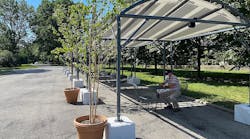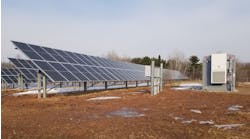Solar power use is growing steadily, powered by dropping costs, increasing system efficiency and installation incentives. Photovoltaic panels are no longer the same silicon rooftop systems you’re used to—they’re popping up in new places and may soon be made of new materials.
We’ve identified three top solar trends to keep your eye on.
1. Solar with storage is growing.
It’s becoming more common to add energy storage systems to solar installations. Storage systems allow you to save up some energy when it’s cheap—for example, when your renewables are generating it for you—and then use the stored energy when grid power is more expensive, such as during peak usage periods.
“Storage is the future of energy for building managers looking to reduce costs and add more resilient forms of power,” explained Eric Potts, executive vice president of commercial Americas at SunPower. “Solar with storage provides a lower cost of energy than commercial buildings can get from their utility. With weather events and increased electricity demand taxing the grid, storage enables buildings to maintain power in blackouts and outages.”
Lithium-based batteries are the most common commercial storage solution, Potts said. They’re relatively compact—most storage installations for SunPower’s medium-sized customers take up the equivalent of one or two parking spaces. The actual footprint (as well as the number of solar panels to pair with them) will vary depending on how much of your energy needs you’re hoping to generate with your solar panels, Potts said.
“If net metering is an option in your area, you might want to install even more solar and storage to take advantage of the credit you could receive by sending unused solar energy back into the grid,” Potts added. “Understanding the specific energy needs for your operation is a good first step.”
[Related: This HVAC Unit is Solar-Powered]
2. Perovskite solar panels may soon hit the market.
The National Renewable Energy Laboratory (NREL) has been researching the capabilities of solar panels made from perovskite, an extremely efficient crystal structure that could one day replace the traditional silicon-based panels that dominate the market right now.
“The reason people are excited about perovskite is that they’re extremely cheap to make because they’re made from low-cost materials, and they can be printed,” said Lance M. Wheeler, a research scientist in chemistry and nanoscience for NREL. “The same way you make a newspaper, you can make a perovskite solar cell. They’re also extremely efficient—they’re close to surpassing silicon right now, which is the incumbent technology you find everywhere.”
Perovskite cells are made of layers of material sandwiched together, according to NREL. The top and bottom layers help convert sunlight to electricity. NREL’s current research focuses on increasing the cells’ efficiency and durability. Once the cells are durable enough and can be deployed on a large scale without losing efficiency, they’ll be ready for prime time. Wheeler estimated this could be as soon as three to five years from now.
“You think of solar as a panel you attach to the rooftop in a large-scale deployment, but because of the flexibility of perovskites, you can integrate them anywhere,” Wheeler said. “Any surface that sees the sun, you can electrify. Having a printable, high-efficiency technology like perovskite enables that.”
[Related: Solar Fabric Canopies]
3. New installations are putting PV everywhere.
Solar isn’t just for roofs anymore. Adventurous companies are pushing the limits of where solar can go and putting solar panels in new places, like the solar-powered fabric that Pvilion creates. The fabric, which generates about 10-15W per square foot, is used to create solar sails, canopies and tents that provide shade, shelter and power for charging devices or powering up equipment.
The explosion of outdoor dining during COVID-19 has created a boom in demand for awnings and canopies that can also charge diners’ phones, said Pvilion CEO Colin Touhey. One recent project involved installing eight of the canopies at the New York Botanical Gardens. Seven of them feed energy back into the grid, and the other one is tied to a bank of batteries to store power for future use.
“One trend we’re seeing is the desire for more power in more places,” Touhey said. “That’s borne out of demand for people to be sitting outside, eating, relaxing and hanging out with their friends, but it’s also borne out of everyone’s need for constant power all the time. That trend is growing significantly, and when you combine that with outdoor dining and people’s desire to be outside more, the intersection is quite obvious.”
Amenities like solar canopies are part of a growing trend of micro-distributed solar generation, “where you’re generating solar very locally and using it in the same place,” Touhey explained. “You generate solar on an umbrella, and you use it on the pole of the umbrella when you charge your phone. There’s a big trend in not thinking of solar as something that’s tied to the utility grid, but something off the grid that you can offer your customers.”
Read next: Top Tips for Integrating Solar Panel Systems on Your Commercial Building



